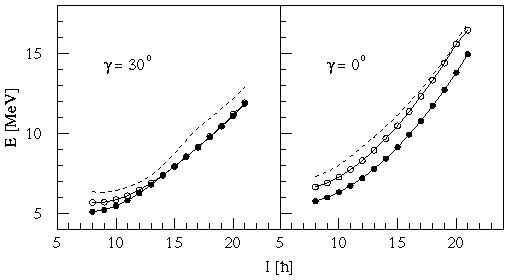| Chiral Symmetry and Particle Rotor Model | |||||||||||
|---|---|---|---|---|---|---|---|---|---|---|---|
| Jing-ye Zhang1, P.B. Semmes2, L.L. Riedinger1, F. Dönau | |||||||||||
|
The study of chiral bands in triaxially deformed nuclei [1]
within the 3d-Tilted Axis cranking Model (TAC)
has shown that the aplanar geometry of the angular momentum
vector < [I\vec] > exists only in a relatively short spin and frequency interval.
This is because the energetical minimum stabilizing such an aplanar orientation
is rather shallow and it can be easily driven towards a principal plane.
Thus, for higher frequencies the favored a.m. direction returns to the
normal (planar) tilt although the triaxial shape may still stay closely at
maximal triaxiality g = 30o.
Therefore, the question arises how sensitive is the aplanar spin orientation
of the TAC model against the possible quantum interference (tunneling)
in between the symmetry-related minima of the potential energy surface.
This question goes beyond the TAC mean field model but can be investigated
by symmetry restoration. A simple approach to it is the rotor plus particle
model (RPM) in which a triaxial rotor core is coupled to two external
high-j quasiparticles.
The RPM is empirical with regard to the moments of inertia and the
coupling to the deformed field which enter in terms of adjustable parameters.
However, the above mentioned symmetry restoration of the RPM is by construction
exactly carried out since the angular momentum is an exact quantum number
of the model.
In addition, the calculation of the important transition matrix elements
is easily done and it automatically implies good a.m. states too.

Fig. 1 Calculated energy E vs. spin I for the three lowest bands of a rotor (left: g=30o, right: g=0o ) two quasiparticle system. Only the triaxial rotor displays the chiral doublet structure.
1 Department of Physics and Astronomy, University of Tennessee,
TN 37996, USA
References
|